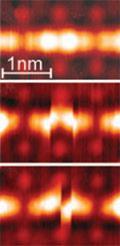Platinum dimers form nano-scale flippers
Scientists in the Netherlands have made platinum nanostructures that act like a pair of pinball flippers when triggered by electric current.
Harold Zandvliet and colleagues at the University of Twente discovered the atomic flippers accidentally, when making nanowires by depositing platinum onto a germanium surface. These nanowires, just a single atom wide, are made of rows of two atom platinum dimers.
While the majority of the dimers are fixed to the surface, Zandvliet noticed that certain dimers repeatedly changed position when the surface was studied by scanning tunnelling microscopy (STM). One atom of the dimer appeared to be fixed to the surface, acting like a pivot around which the other atom rotates. The team also found examples where two rotating dimers were positioned next to each other on the surface - like a pair of flippers on a pinball machine.

By correlating current with flipping frequency, Zandvliet showed that the flippers only move when triggered by the electric current from the STM. Zandvliet also found that, by changing the current and the relative position of the STM tip, the two flippers could be moved together or independently, in or out of phase.
But quite why certain dimers behave like flippers is still uncertain, says Zandvliet. ’We can find them on the surface - but we don’t know how to change the conditions to get more of these flippers on the surface,’ he adds.
The team initially suspected the motion might be due to something on the germanium surface - most likely hydrogen, which is so small it is difficult to detect by STM. ’We dosed the surface with hydrogen, but this didn’t increase the density of flippers, so that idea was ruled out,’ says Zandvliet. However, closer inspection of the STM images revealed that the flippers sit closer to the germanium surface than normal dimers. ’We have a feeling - although we can’t prove it - that there must be an atom missing in the subsurface region, which is probably the reason that these dimers can move a little,’ he adds.
’It’s an intriguing observation,’ says Philip Moriarty at the University of Nottingham, UK. ’They’ve done a really neat analysis to show that this is purely a current-related effect. Because they can’t characterise the surface at the atomic level, it’s not clear why these dimers behave differently to others on the surface - but in the absence of any other evidence, their hypothesis seems sound.’
Quite what the flippers could be used for is another question. ’We don’t see any applications for it,’ says Zandvliet. ’We stumbled on it by luck, and immediately decided to devote some work to it because it’s an interesting feature - and can teach you something about the possibilities on the nanoscale.’
James Mitchell Crow
References
A Saedi et al, Nano Lett., 2008, DOI: 10.1021/nl8022884






No comments yet